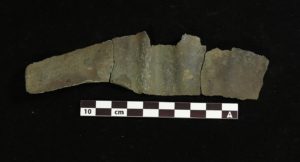
PROCEEDINGS OF THE NATIONAL ACADEMY OF SCIENCES—Researchers report* early metal use and crematory practices by indigenous groups in the southeastern United States. The long-distance trade of goods such as copper during the Archaic Period, around 3,000-8,000 years ago, contributed to social complexity among indigenous groups in eastern North America. Although widespread in certain areas of eastern North America, Archaic Period copper is largely absent from archaeological sites in the southeastern United States. Matthew Sanger, David Thomas, and colleagues report a copper band alongside the cremated remains of at least seven individuals at a burial site in coastal Georgia, where, in addition to copper, Archaic Period cremations are absent from the archaeological record. The copper band and burials were located in the center of a Late Archaic shell ring–circular deposits likely used in ritual gatherings and feasting events. Radiometric dating indicated that the remains were from the Late Archaic Period, and elemental composition analysis of the band revealed that the copper originated in the Great Lakes region, extending previously documented boundaries of Archaic Period copper exchange by nearly 1,000 km. Additionally, the cremation practices at the site resembled those native to the Great Lakes region, indicating long-distance cultural exchange among Archaic Period indigenous groups in the region. According to the authors, the findings lend insight into emergent patterns of hierarchical social organization in the Archaic southeastern United States.
_________________________________

A Late Archaic copper artifact from a shell ring in coastal Georgia. American Museum of Natural History
_________________________________
*”Early metal use and crematory practices in the American Southeast,” by Matthew Sanger et al.
Article Source: PNAS news release





